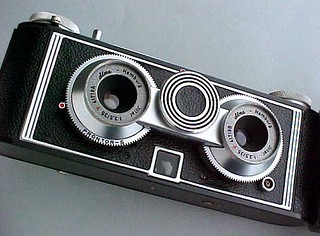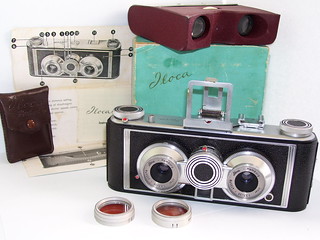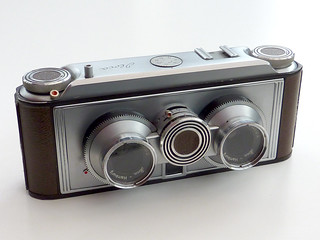Difference between revisions of "Iloca Stereo II"
(→Iloca Stereo IIa: saw one with different lens, adding that to the write up) |
|||
| Line 16: | Line 16: | ||
Iloca changed the format of the pictures to the Realist (5p) standard 23×24mm stereo pairs from the European version used in the [[Iloca Stereo|Iloca Stereo I and Ia]]. This simplified the film loading and allowed 30 images per roll. | Iloca changed the format of the pictures to the Realist (5p) standard 23×24mm stereo pairs from the European version used in the [[Iloca Stereo|Iloca Stereo I and Ia]]. This simplified the film loading and allowed 30 images per roll. | ||
| − | This camera | + | This camera has two Jilitar 3.5cm f/3.5 lenses, separated ~70mm with coupled focusing. |
| − | It was fitted with Prontor-S | + | The lenses accepted series V filters and accessories (32mm push-on or 30mm screw). |
| − | The Newton optical finder | + | It was fitted with a central Prontor-S shutter (B,1-300). |
| + | The Newton optical finder is in an unusual location, below the taking lenses, and is very small for today's standards. An accessory rapid finder was available, which had a spirit level built in<ref>[https://iloca.weebly.com/iloca-stereo-viewfinder-with-built-in-spirit-level.html Accesories] At the Iloca tribute webpage</ref>. | ||
The camera has double-exposure prevention built in, but a small lever allows for intentional double exposures. | The camera has double-exposure prevention built in, but a small lever allows for intentional double exposures. | ||
Film advance an rewind levers are on top of the camera, and shutter must be cocked before shooting. | Film advance an rewind levers are on top of the camera, and shutter must be cocked before shooting. | ||
| + | ''(Before shooting, the film sprocket wheel must be moved to allow the shutter release)'' | ||
It was also sold by [[Montgomery Ward]] as the '''Photrix Stereo'''.<ref>{{McKeown12}} Page 444.</ref> | It was also sold by [[Montgomery Ward]] as the '''Photrix Stereo'''.<ref>{{McKeown12}} Page 444.</ref> | ||
| Line 46: | Line 48: | ||
==Iloca Stereo IIa== | ==Iloca Stereo IIa== | ||
| + | An improved version, was named IIa and produced from 1954 to 1956. It brought mostly cosmetic changes to the II and used the same lenses, shutter and accessories. However, some late examples use [[Isco|Isco-Göttingen]] Westar 35/3.5mm lenses or Isconar 35/3.5 (Cooke triplets) and some were coated (marked with a red C). The camera is large (1875x82x60mm) and heavy (770 g) | ||
| − | + | Among the changes, film advance and rewind wheels were moved to be flushed with the top of the camera, leatherette and chrome trim were also changed. In this camera the intentional double exposure has been removed. The shutter cocking lever also serves as a rewind clutch. | |
| − | |||
| − | |||
| − | The | ||
This camera was sold by Sears as [[Sears|Tower 83 Stereo]] in the USA. | This camera was sold by Sears as [[Sears|Tower 83 Stereo]] in the USA. | ||
| Line 75: | Line 75: | ||
|image_rights= cc | |image_rights= cc | ||
}} | }} | ||
| − | |||
|} | |} | ||
Revision as of 21:24, 7 December 2022
|
The Iloca Stereo II camera was made by Iloca from 1951 to 1953.
Iloca changed the format of the pictures to the Realist (5p) standard 23×24mm stereo pairs from the European version used in the Iloca Stereo I and Ia. This simplified the film loading and allowed 30 images per roll.
This camera has two Jilitar 3.5cm f/3.5 lenses, separated ~70mm with coupled focusing. The lenses accepted series V filters and accessories (32mm push-on or 30mm screw). It was fitted with a central Prontor-S shutter (B,1-300). The Newton optical finder is in an unusual location, below the taking lenses, and is very small for today's standards. An accessory rapid finder was available, which had a spirit level built in[1].
The camera has double-exposure prevention built in, but a small lever allows for intentional double exposures. Film advance an rewind levers are on top of the camera, and shutter must be cocked before shooting. (Before shooting, the film sprocket wheel must be moved to allow the shutter release)
It was also sold by Montgomery Ward as the Photrix Stereo.[2]
|
|
Iloca Stereo IIa
An improved version, was named IIa and produced from 1954 to 1956. It brought mostly cosmetic changes to the II and used the same lenses, shutter and accessories. However, some late examples use Isco-Göttingen Westar 35/3.5mm lenses or Isconar 35/3.5 (Cooke triplets) and some were coated (marked with a red C). The camera is large (1875x82x60mm) and heavy (770 g)
Among the changes, film advance and rewind wheels were moved to be flushed with the top of the camera, leatherette and chrome trim were also changed. In this camera the intentional double exposure has been removed. The shutter cocking lever also serves as a rewind clutch.
This camera was sold by Sears as Tower 83 Stereo in the USA.
The Iloca Stereo Rapid was the successor of this camera, and the last stereo camera made by Iloca.
|
|
Notes
- ↑ Accesories At the Iloca tribute webpage
- ↑ McKeown, James M. and Joan C. McKeown's Price Guide to Antique and Classic Cameras, 12th Edition, 2005-2006. USA, Centennial Photo Service, 2004. ISBN 0-931838-40-1 (hardcover). ISBN 0-931838-41-X (softcover). Page 444.




